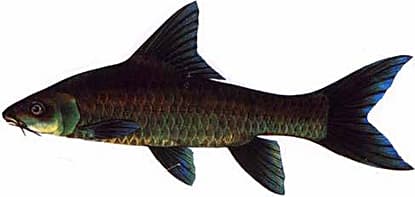Thai Mahseer – Tor tambroides – Thai Fish Species
Species: Tor tambroides.
Common names: Greater Brook Carp, Thai Mahseer. Thai Name: Pla Wien.
Distribution: Found in Southeast Asia. There are reported catches from Malaysia, Thailand, Sumatra, Java, also Borneo, and Myanmar (Burma).
Habitat: They inhabit specific types of habitats characterized by clear, well-oxygenated rivers and streams in hilly and mountainous regions. The clarity of the water is essential for their survival, as it allows them to spot prey and navigate effectively. These fish are well-adapted to environments with fast-flowing currents. They can withstand strong water currents and are often found in areas with riffles and cascades. The water temperature in their habitat can vary depending on the region and elevation but is generally cool to moderately warm. These fish are adapted to a range of temperatures within their native range.
Prefer habitats with rocky or gravelly substrates. These substrates provide shelter, breeding sites, and places to forage for food. While they are often found in fast-flowing water. Thai Mahseer may seek sheltered areas along the riverbanks, particularly during the hottest parts of the day. Overhanging vegetation or submerged tree roots can provide shade and refuge. It’s worth noting that the conservation of Thai Mahseer and their habitat is of great importance. Habitat degradation, pollution, and overfishing are threats that can negatively impact their populations. Conservation efforts often focus on preserving the pristine river and stream ecosystems where Thai Mahseer thrives to ensure the long-term survival of this species in its natural habitat.
 Thai Mahseer (Tor tambroides)
Thai Mahseer (Tor tambroides)
Is a freshwater fish species in the Cyprinidae family of the order Cypriniformes (Carp). They are a striking and beautifully colored freshwater fish known for their distinctive appearance. They have a streamlined compact body, which is typical of fish adapted for fast-flowing rivers and streams. The most notable feature of the Thai Mahseer is its vibrant and eye-catching coloration. Juveniles have a gold/bronze-colored scales with a prominent and dark lateral line. This line is a sensory organ that helps the fish detect vibrations and changes in water pressure, assisting them in navigating turbulent waters. The stripe also helps them blend in with their surroundings and provide camouflage. Their dorsal (back) fin, anal (ventral) fin and caudal fin (tail fin), as well as the pectoral and pelvic fins, are usually, transparent-tinged with a hint of light blue.
As they mature their coloration can change
Adults Thai Mahseer often have a more solid and subdued coloration, with shades of olive-green or brown on the upper part of their bodies and a lighter, gold/bronze- color on the lower part of their bodies. They may still retain some remnants of the juvenile stripe. The coloration can vary somewhat depending on their specific habitat, and water conditions. Fish in clearer waters might exhibit brighter colors, like Silver Grey/with a hint of light blue, while those in murky or tannin-stained waters might have darker hues. It’s important to note that the coloration of fish can also be influenced by factors like diet, and breeding conditions. Therefore, the appearance can vary from one individual to another and over time. These fish are highly adaptable and can change their coloration to some extent to match their surroundings and conditions.
The tail fin is forked, which aids in their agility and maneuverability in fast-moving water. Their eyes are relatively large and positioned laterally on their heads, allowing for a wide field of vision. They have a fleshy, protrusible mouth with thick lips, well adapted for bottom feeding. Small barbels, which are fleshy, whisker-like, that help them locate food in murky waters. They also have a median lobe, which is used for digging in the bottom. Thai Mahseer is of the genus Tor and is considered a “true mahseer” with the presence of the median lobe, as opposed to Neolissochilus and Naziritor, where it is not present.
This fish’s beauty and sporting qualities make it a sought-after catch among anglers Thai Mahseer are an outstanding game fish, they are one of the fiercest fighting freshwater game fish in existence. Pound for pound it has unparalleled strength and endurance. They are hard-hitting and fight like tigers when hooked, using the rocks, rapids and the currents of the flowing jungle rivers, to their advantage.
Thai Mahseer Lifespan and Size
The lifespan of a Thai Mahseer can vary depending on a range of factors, including environmental conditions, habitat quality, and predation risks. In general, they have a relatively long lifespan for a fish species. On average, Thai Mahseer can live for 15 to 20 years in the wild. However, under optimal conditions with limited predation and access to suitable food sources, some individuals have been known to live even longer, possibly reaching up to 25 years or more. The size can vary significantly depending on their diet, environmental conditions, and the specific population and location where they are found. In areas with optimal habitats and food availability, they can grow up to more than 100 cm in length and 20 kg, + in weight. The present world record is 12 kilograms (26 lb. 7 oz). Caught in the waters of Jeram Besu, Benta, Pahang, Malaysia, on July 24, 2001.
Thai Mahseer Diet
The diet of the Thai Mahseer is omnivorous, which means they consume a variety of food items, including both animal and plant matter. Their diet can vary depending on factors such as their age, the availability of food in their habitat, and local environmental conditions. They often feed on aquatic insects such as mayflies, caddisflies, dragonflies, and various aquatic larvae. Small crustaceans, including freshwater shrimp and crayfish, are another important part of their diet.
They may consume the fry (young fish) of other fish species, this behavior is more common among larger individuals. Thai Mahseer are also known to feed on algae and aquatic plants, particularly when animal prey is less abundant. They may graze on submerged vegetation and algae as a source of nutrients. They also eat a variety of other aquatic invertebrates, including small snails, worms, and small crustaceans. Their diet can be opportunistic, meaning they consume what is available in their environment. As omnivores, they have a flexible diet that allows them to adapt to changing food availability and environmental conditions.
Thai Mahseer Breeding Timeline
The spawning timeline of Thai Mahseer can vary depending on various environmental factors, including water temperature, rainfall, and the specific geographic location within their native range. They typically begin their reproductive activities in the early wet season when there is an increase in water flow and water levels due to rainfall. This period often coincides with lower water temperatures. As the wet season progresses, they migrate to specific spawning sites. These sites are typically located in clear, fast-flowing rivers and streams with suitable substrates like gravel or rocky bottoms.
Thai Mahseer are substrate spawners, which means they deposit their eggs on clean, hard surfaces. Spawning usually occurs in groups, with males and females engaging in courtship rituals. The female releases her eggs while the male simultaneously releases sperm to fertilize the eggs externally. This behavior often involves multiple pairs of fish. After fertilization, the eggs adhere to the substrate. The duration of egg development varies depending on water temperature but typically lasts from several days to a few weeks.
Once the eggs hatch
The young, known as fry, emerge. They begin feeding on tiny aquatic organisms and grow rapidly. The fry continues to grow and develop during the early dry season. They may stay in relatively protected habitats within the river or move to calmer waters to avoid predation. Over the dry season and into the next wet season, the fry grows and matures into juveniles. They may disperse into various habitats within the river system. This Mahseer species typically follow this annual spawning cycle, with the timing of each stage influenced by local environmental conditions. As the wet season returns, adult Thai Mahseer may once again migrate to spawning sites to repeat the process. It’s important to note that specific timing can vary based on regional and local factors, and some populations may have slightly different spawning timelines.
Gender
Gender determination of Thai Mahseer can be challenging, especially when they are not actively breeding or displaying clear sexual dimorphism. However, there are some certain physical characteristics and behaviors that can help distinguish between males and females. In some cases, females may grow slightly larger and faster than males, especially when they are actively breeding. However, this size difference is not always reliable for sex determination. During the breeding season, males often exhibit more vibrant and intense coloration compared to females. They may develop brighter and more distinct colors, especially on their fins and body. Males may engage in courtship behaviors such as chasing females or engaging in territorial disputes. These behaviors can provide clues to their sex, but they should be observed in the context of the breeding season.
Males may have a slightly slender and streamlined body shape, while females might appear slightly plumper, particularly when they are carrying eggs. Some males may have more extended fin rays on their dorsal and anal fins during the breeding season. These fin extensions can be more pronounced than in females. In some cases, you can observe differences in the genital papillae, a small, fleshy projection located just behind the anal fin. In males, this papilla may be more pointed or elongated, while in females, it may be shorter and rounder. However, this method is not always reliable, especially in non-breeding individuals.
Fishing method
Lure fishing can be highly effective, lures like Rapala wobblers, spinners like Mepps or Wibrax and spoons, that have had their split rings and hooks swapped to stronger versions, are ideal. Plugs that imitate the local baitfish will increase your chances of a take. It is also a fish that will take flies. They will take nymphs, streamers and dry flies. Mahseer fly fishing is a newly developed type of fly fishing in Thailand. Targeting the hard-fighting Thai Mahseer on the fly can be challenging for the fly fishermen. One of the biggest challenges is not to spook this shy and reclusive predator.


 Thai Mahseer (Tor tambroides)
Thai Mahseer (Tor tambroides)